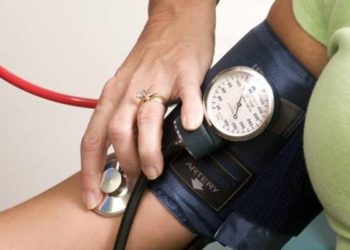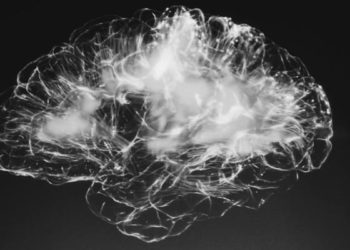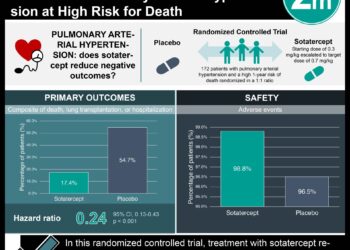The risk of dementia is associated with being greater at the extremes of systolic blood pressure in adults 75 or older
1. Systolic blood pressure (SBP) was in a U-shaped relationship with risk of dementia n the cohort aged >75 with the lowest dementia risk at 165 mmHg, and increased risk of dementia at higher or lower SBP.
2. Mortality had an approximately U-shaped associated with SBP for all age ranges, with the lowest risk at 134 mmHg in the 60- to 70-year-olds and 160 mmHg in the >70-year-olds.
Evidence Rating Level: 2 (Good)
Study Rundown: Previous studies demonstrated that the risk of dementia is increased by mid-life, but not later-life, hypertension. One theory for the lack of association between late-life hypertension and dementia is that the hypotensive comparator group is also associated with dementia. This cohort study investigates if dementia risk is greatest at the extremes of systolic blood pressure (SBP) (i.e. “U-shaped”) for various age groups. This cohort study recruited from previous studies on SBP and dementia. The relationship between baseline SBP and risk of dementia diagnosis, stratified by age, was plotted and the fit was tested with Cox proportional hazards regression models. The same was performed on the secondary outcome measure of mortality. 16.2% of the 17286 enrolled participants were diagnosed with dementia during the average 7.3 years of follow-up. SBP and dementia had an inverse linear relationship with the lowest risk of dementia at an SBP of 185mmHg. SBP had an approximately inverse linear relationship with dementia in the 70- to 80-year-olds but was U-shaped in the 75- to 95-year-old group with the vertex (point of minimum dementia risk) occurring at a SBP of 165 mmHg. Mortality had an approximately U-shaped associated with SBP for all age ranges, with a vertex at an SBP of 134 mmHg in the 60- to 70-year-olds and 160 mmHg in the >70-year-olds. The point on the association curve of lowest mortality was at a higher SBP for anti-hypertensive users than non-users and was higher for older anti-hypertensive users than younger anti-hypertensive users. Having a history of stroke altered the association of dementia with SBP such that the point of lowest dementia risk was a low, not high, SBP. A strength of this study is that it employs a rigorous Diagnostic and Statistical Manual of Mental Disorders definition diagnosing dementia in the studies from which it gathers participants. This study has a large sample size and considers representing a wide range of age and SBP when selecting its cohort. To address the potential for one cohort to have undue sway affecting the conclusions of this study, particularly at the extremes of age, this study performed a leave-one-out sensitivity analysis. Confounding variables were investigated with a systematic pre-defined subgroup analysis. A final strength of this study is its use of bootstrapping to define confidence intervals around the association line to identify if they are sufficiently narrow to draw conclusions about the shape. This study is limited because all the cohorts are from Western countries, this data is not globally generalizable. There is the potential for misclassification of exposure in the subgroup analysis was it performed based on group membership at baseline.
Click to read the study in JAMA Internal Medicine
Relevant Reading: Association of Blood Pressure Lowering With Incident Dementia or Cognitive Impairment: A Systematic Review and Meta-analysis
In-Depth [retrospective cohort]: Participants with baseline SBP and later incidental all-cause dementia diagnosis from previous cohort studies was analyzed to identify an association. Multivariate analysis assessed whether baseline antihypertensive medication use, sex, educational level, body mass index, smoking status, diabetes, stroke history, myocardial infarction history, and the number of medications used affected the risk of dementia diagnosis or morbidity at various SBPs. Of 17286 participants (age = 74.5±7.3 years, age range = 65-95, 60.1% women) from 7 studies, 16.2% were diagnosed with dementia over an average of 7.3 years of follow-up. The association between SBP and dementia was approximately inverse linear, where the high SBP of 185mmHg was associated with the lowest dementia risk (95% CI = 161-230mmHg, P = 0.001). The lowest mortality risk was associated with an SBP of 160 mmHg (95% CI = 154-181 mmHg, P < 0.001). Overall, the lowest risk of mortality and dementia was associated with 163mmHg (95% CI = 158-197mmHg, P < 0.001). These results were similar for diastolic blood pressure (DBP). When stratified by age, SBP had an approximately inverse linear relationship with dementia for the 70- to 80-year-old group. This relationship was approximately U-shaped for the 75- to 95-year-old group with the lowest risk of dementia at a SBP of 165 mmHg (95% CI = 152-178mmHg, P < 0.001). Mortality had an approximately U-shaped associated with SBP for all age ranges. Mortality was lowest at a low SBP of 134 mmHg in the 60- to 70-year-olds (95% CI = 102-149 mmHg, P = 0.03), but lowest at the higher SBP of 160 mmHg in the >70-year-olds (95% CI = 150-166mmHg, P < 0.001). Anti-hypertensive medication decreased the association between SBP and mortality (Akaike information criterion [AIC] = -5.1, P = 0.01). >70-year-old anti-hypertensive users minimum mortality point at 160 to 170mmHg was greater than that of 60–70-year-old anti-hypertensive users at 145 mmHg. Subgroup analysis suggested that only a positive stroke history, compared to negative history, altered the association of dementia with SBP (AIC = –1.88, P = 0.048). Specifically, in those with a history of stroke, the lowest dementia risk point occurred at an SBP of 100mgHg (95% CI = 100-216mmHg, P = 0.24), while in those with a stroke the lowest dementia risk occurred at a higher SBP of 229mmHg (95% CI = 161-229mmHg, P = 0.03).
Image: PD
©2021 2 Minute Medicine, Inc. All rights reserved. No works may be reproduced without expressed written consent from 2 Minute Medicine, Inc. Inquire about licensing here. No article should be construed as medical advice and is not intended as such by the authors or by 2 Minute Medicine, Inc.







